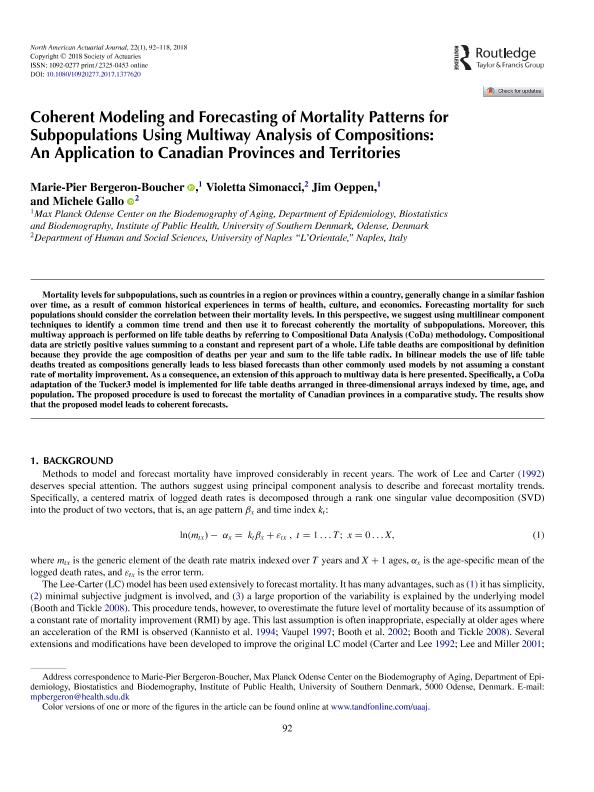Coherent modeling and forecasting of mortality patterns for subpopulations using multiway analysis of compositions : an application to Canadian provinces and territories

Contenido multimedia no disponible por derechos de autor o por acceso restringido. Contacte con la institución para más información.
| Tag | 1 | 2 | Value |
|---|---|---|---|
| LDR | 00000cab a2200000 4500 | ||
| 001 | MAP20180017025 | ||
| 003 | MAP | ||
| 005 | 20180615131305.0 | ||
| 008 | 180606e20180301usa|||p |0|||b|eng d | ||
| 040 | $aMAP$bspa$dMAP | ||
| 084 | $a6 | ||
| 100 | $0MAPA20180008085$aBergeron-Boucher, Marie-Pier | ||
| 245 | 1 | 0 | $aCoherent modeling and forecasting of mortality patterns for subpopulations using multiway analysis of compositions$b : an application to Canadian provinces and territories$cMarie-Pier Bergeron-Boucher, Violetta Simonacci, Jim Oeppen, Michele Gallo |
| 520 | $aMortality levels for subpopulations, such as countries in a region or provinces within a country, generally change in a similar fashion over time, as a result of common historical experiences in terms of health, culture, and economics. Forecasting mortality for such populations should consider the correlation between their mortality levels. In this perspective, we suggest using multilinear component techniques to identify a common time trend and then use it to forecast coherently the mortality of subpopulations. Moreover, this multiway approach is performed on life table deaths by referring to Compositional Data Analysis (CoDa) methodology. Compositional data are strictly positive values summing to a constant and represent part of a whole. Life table deaths are compositional by definition because they provide the age composition of deaths per year and sum to the life table radix. In bilinear models the use of life table deaths treated as compositions generally leads to less biased forecasts than other commonly used models by not assuming a constant rate of mortality improvement. As a consequence, an extension of this approach to multiway data is here presented. Specifically, a CoDa adaptation of the Tucker3 model is implemented for life table deaths arranged in three-dimensional arrays indexed by time, age, and population. The proposed procedure is used to forecast the mortality of Canadian provinces in a comparative study. The results show that the proposed model leads to coherent forecasts | ||
| 650 | 4 | $0MAPA20080555306$aMortalidad | |
| 650 | 4 | $0MAPA20080579258$aCálculo actuarial | |
| 650 | 4 | $0MAPA20080592011$aModelos actuariales | |
| 650 | 4 | $0MAPA20080611613$aModelos probabílisticos | |
| 650 | 4 | $0MAPA20080602437$aMatemática del seguro | |
| 651 | 1 | $0MAPA20080637712$aCanadá | |
| 700 | 1 | $0MAPA20180008122$aSimonacci, Violetta | |
| 700 | 1 | $0MAPA20180008139$aOeppen, Jim | |
| 700 | 1 | $0MAPA20180008146$aGallo, Michele | |
| 773 | 0 | $wMAP20077000239$tNorth American actuarial journal$dSchaumburg : Society of Actuaries, 1997-$x1092-0277$g05/03/2018 Tomo 22 Número 1 - 2018 , p. 92-118 |

